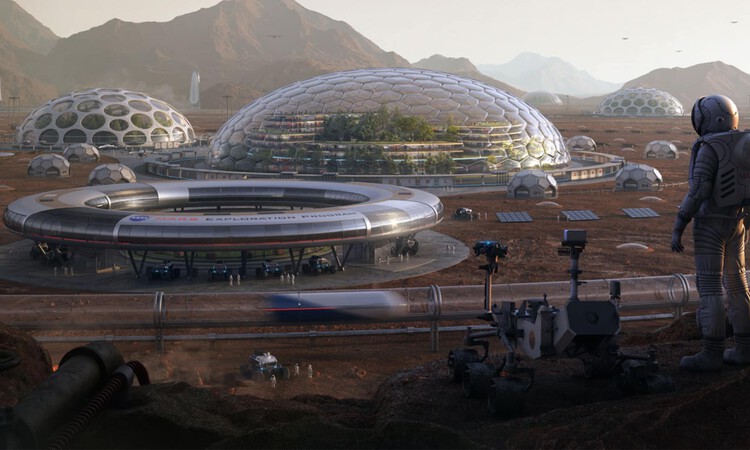Space architecture is at the forefront of humanity’s journey into the cosmos. It combines aerospace engineering, architecture, and design to create habitats for humans in space. Starting from basic survival needs, space architecture has evolved into creating sustainable and comfortable living spaces.
There are questions that popular culture has depicted humans inhabiting and colonizing plaets such as Alpha Centauri and Titan. It is a vast subject capturing the interests of the coming generation of architects and futurists.
Our blog will explore the work of space agencies and architectural firms leading this field. NASA, ESA, SpaceX, and others are working with visionary architects to develop innovative solutions for space habitation. From modular habitats on the Moon and Mars to futuristic spaceports and orbiting cities, these projects represent the latest in space architecture. By collaborating across disciplines and using advanced technologies like 3D printing and robotics, space architecture is helping humanity expand into space. Join us as we discover these groundbreaking designs shaping the future of space living.
Understanding Space Architecture
Space architecture involves the intricate process of designing and constructing inhabited environments in outer space. This discipline encompasses the architectural design of living and working spaces in various extraterrestrial settings, including space vehicles, space stations, habitats, and bases on celestial bodies such as the Moon and Mars. The primary objective is to create functional and livable spaces that can withstand the harsh conditions of space, including extreme temperatures, radiation, and microgravity. Over the years, space architecture has evolved significantly, driven by advancements in technology and a deeper understanding of space environments. Early space habitats were primarily focused on ensuring the survival of astronauts, but contemporary designs strive to provide sustainable, comfortable, and psychologically supportive environments.
Key considerations in space architecture include safety, sustainability, habitability, and the psychological well-being of astronauts. Safety is paramount, as structures must be able to protect inhabitants from space hazards such as micrometeoroids and cosmic radiation. Sustainability involves the efficient use of resources, recycling, and the ability to generate life-support essentials like oxygen and water. Habitability focuses on creating spaces that support daily activities, work, and rest, ensuring that astronauts can live and work effectively. Additionally, the psychological well-being of space inhabitants is crucial, requiring designs that incorporate elements to combat isolation, stress, and the monotony of long-duration missions. Innovative technologies such as 3D printing and robotics play a vital role in achieving these goals, allowing for the construction of habitats using locally sourced materials and the automation of complex building processes.
Architectural Projects for Life in Space
Space architecture projects showcase a range of innovative concepts designed to support human life in extraterrestrial environments. These projects often utilize cutting-edge technologies such as 3D printing, autonomous robotics, and sustainable resource management to create habitats that are both functional and habitable. By addressing the unique challenges of space living, these architectural endeavors pave the way for future space exploration and long-term human presence beyond Earth.
Here are some notable examples:
Lunar Living by Foster + Partners
In collaboration with the European Space Agency (ESA), Foster + Partners presented the “Lunar Habitation” project in 2012, a visionary endeavor that explores the potential of 3D printing technology to construct sustainable housing on the Moon. The project is strategically designed for the Moon’s south pole, an area characterized by nearly constant sunlight, which is crucial for providing a reliable energy source through solar power. This innovative design aims to house up to four people, ensuring not only their survival but also their comfort in the harsh lunar environment.
The Lunar Habitation project leverages local lunar materials to create the building structures, significantly reducing the reliance on materials transported from Earth. This approach not only minimizes the logistical challenges and costs associated with space missions but also embodies principles of sustainability and self-sufficiency. The habitat’s design incorporates a robust shell built from lunar regolith, which is 3D printed to form a protective barrier against micrometeoroids, radiation, and extreme temperatures. Inside, the habitat offers a habitable environment with living quarters, workspaces, and communal areas designed to support the astronauts’ physical and psychological well-being during their stay on the Moon. Foster + Partners’ Lunar Habitation project exemplifies the integration of advanced technologies and innovative architectural strategies to pave the way for sustainable human presence beyond Earth.
Mars Science City by BIG + Mohammed bin Rashid Space Center
Presented in 2017, Mars Science City is a groundbreaking project aimed at simulating the living conditions on Mars. This ambitious initiative is a collaboration between the renowned architectural firm Bjarke Ingels Group (BIG) and the Mohammed bin Rashid Space Center. Mars Science City is designed as an experimental city that will serve as a testbed for developing and refining the technologies and strategies necessary for sustainable human habitation on the Red Planet.
One of the most innovative aspects of Mars Science City is its use of 3D printing technology to construct buildings and infrastructure using local sand from the Emirati desert. This approach mimics the potential use of Martian soil, or regolith, in future Mars settlements, significantly reducing the need to transport building materials from Earth. The structures within Mars Science City are designed to withstand the harsh conditions of Mars, including extreme temperatures, high levels of radiation, and the planet’s dusty environment.
The city will serve as a living laboratory where scientists, engineers, and architects can conduct experiments and research to develop building techniques and life-support systems that ensure the safety and comfort of future Mars inhabitants. The project includes various facilities such as residential units, research laboratories, food production areas, and recreational spaces, all aimed at replicating a self-sustaining Martian habitat. The goal is to simulate a year-long mission to Mars, allowing researchers to study the psychological and physiological effects of living in an isolated and confined environment.
Mars Science City not only represents a significant step towards the colonization of Mars but also provides valuable insights into sustainable living practices that can be applied on Earth. By addressing the challenges of creating a livable environment on Mars, the project contributes to advancing our understanding of sustainable architecture, resource management, and human resilience in extreme conditions.
Marsha by AI SpaceFactory
Winner of NASA’s “Centennial Challenge,” the Marsha prototype by AI SpaceFactory is a pioneering example of innovative design and engineering aimed at creating habitable environments on Mars. The project employs advanced 3D printing technology, utilizing locally sourced materials such as basalt fiber from Martian rocks and biodegradable plastics, to construct robust and sustainable habitats. This approach not only reduces the need for transporting materials from Earth but also ensures that the habitats are well-suited to the Martian environment.
Also explore about Generative and Algorithmic design in Architecture
The design of Marsha prioritizes livability, focusing on creating spaces that are not only functional but also familiar and comfortable for Earth dwellers. Unlike traditional space habitats, which often have a utilitarian and industrial feel, Marsha aims to provide a sense of home and well-being for its inhabitants. The vertical, cylindrical structure of the habitat maximizes the use of space and allows for natural light to permeate the living areas, enhancing the psychological comfort of the residents. The interior layout includes private sleeping quarters, communal living and dining areas, workspaces, and dedicated spaces for hygiene and recreation, all designed to support the daily activities and social needs of the astronauts.
One of the key innovations of Marsha is its use of basalt fiber, a material derived from Martian rocks, which offers exceptional strength and durability. This material is combined with a bio-plastic binder to create a composite that can be 3D printed into complex, high-performance structures. The habitat’s walls are thick and layered to provide insulation against Mars’ extreme temperatures and protection from radiation. The design also incorporates features to manage life-support systems, including air, water, and waste recycling, ensuring the sustainability and self-sufficiency of the habitat.
By focusing on the human aspects of space habitation, Marsha sets a new standard for what life on Mars would look like. The project demonstrates that it is possible to create environments that not only meet the technical and survival needs of astronauts but also offer comfort, familiarity, and a sense of belonging, which are crucial for long-term missions and the future colonization of Mars.
ICE House by SEArch + Clouds AO
The ICE House, winner of NASA’s “3D Printed Habitat Challenge,” represents a revolutionary approach to sustainable living on Mars. Designed by SEArch (Space Exploration Architecture) and Clouds AO, this habitat utilizes native Martian materials and advanced 3D printing technologies to create a protective and livable environment. Central to its design is the innovative use of frozen water, which serves multiple critical functions such as filtering sunlight to reduce radiation exposure and providing insulation against the planet’s extreme temperatures.
The ICE House is specifically engineered to address the unique challenges posed by Mars’ harsh environment. Its construction method involves using a composite material that combines Martian regolith with water ice, which is abundantly available on the planet’s surface. This approach not only leverages local resources but also minimizes the need for transporting materials from Earth, making future Martian settlements more sustainable and cost-effective.
In addition to its structural innovations, the ICE House integrates advanced life-support technologies to ensure the well-being of its inhabitants. The habitat includes systems for air and water recycling, waste management, and food production, creating a self-sustaining ecosystem capable of supporting long-duration missions on Mars. By pioneering new methods of construction and resource utilization, SEArch and Clouds AO’s ICE House exemplifies the forefront of space architecture, offering a glimpse into the future of human habitation beyond Earth.
Spaceport Gateway by Gateway Foundation
The Spaceport Gateway, envisioned by the Gateway Foundation, represents an ambitious proposal for a futuristic space hotel and spaceport orbiting Earth. At the heart of this visionary concept is a rotating wheel structure designed to generate artificial gravity, offering a comfortable and familiar environment for long-term habitation in space. The project aims to revolutionize space tourism, research, and commercial activities by providing state-of-the-art facilities and amenities in low Earth orbit.
The Spaceport Gateway is designed to cater to a wide range of needs and interests, from adventurous tourists to pioneering scientists and entrepreneurs. The rotating wheel structure not only provides a sense of gravity but also enables residents to enjoy panoramic views of Earth and the cosmos from the comfort of their accommodations. The space hotel features luxurious amenities, including spacious living quarters, recreational facilities, restaurants, and observation decks, offering guests a truly unforgettable experience in space.
In addition to its hospitality offerings, the Spaceport Gateway serves as a vital hub for space exploration and commerce. The spaceport provides docking facilities for spacecraft, allowing for easy access to and from Earth, as well as facilitating rendezvous with other space vehicles and platforms. This strategic location in low Earth orbit enables efficient transportation and logistics for missions to the Moon, Mars, and beyond, fostering collaboration between government agencies, private companies, and international partners in space exploration and development.
By making space more accessible and inviting, the Spaceport Gateway embodies the spirit of human ingenuity and exploration, inspiring a new era of space travel and discovery. With its innovative design and multifunctional capabilities, this project heralds a future where space tourism and commercial activities thrive alongside scientific research and exploration, opening up new opportunities for humanity’s journey into the cosmos.
SpaceX Starship
SpaceX’s Starship represents a groundbreaking advancement in space travel, poised to revolutionize interplanetary exploration and enable humanity’s long-awaited journey to Mars. This ambitious spacecraft, designed by SpaceX CEO Elon Musk and his team, is envisioned as a fully reusable rocket capable of carrying both crew and cargo on missions beyond Earth’s orbit. Starship’s versatility and robust design make it a key player in realizing the dream of human settlement on Mars, marking a monumental leap forward in the history of space exploration.
At the heart of Starship’s design is its reusability, a paradigm-shifting concept that promises to dramatically reduce the cost of space travel and increase its accessibility. By employing innovative technologies such as stainless steel construction and methane-oxygen propulsion, SpaceX aims to create a spacecraft that can be rapidly refurbished and relaunched, making frequent journeys to and from Mars economically feasible. This reusability not only opens up new possibilities for scientific research and commercial ventures but also lays the groundwork for sustainable human presence beyond Earth.
Starship’s capabilities extend far beyond traditional space missions, with the potential to serve as a platform for constructing habitats and infrastructure on Mars. SpaceX envisions deploying habitat modules and other essential components to the Martian surface using Starship, laying the foundation for long-duration space missions and eventual human colonization. With its spacious interior and ample payload capacity, Starship offers unparalleled opportunities for transporting supplies, equipment, and personnel to support future Martian settlements.
The development of Starship represents a monumental step towards achieving Elon Musk’s vision of making humanity a multiplanetary species. By leveraging cutting-edge technology and bold innovation, SpaceX is driving humanity closer to the realization of interplanetary travel and colonization. Starship stands as a testament to the indomitable spirit of exploration and the boundless potential of human ingenuity, inspiring generations to reach for the stars and beyond.
LavaHive
LavaHive presents an innovative concept for habitats constructed using volcanic materials, tailored for the lunar or Martian landscape. These domed structures harness the abundant local resources, such as volcanic rock and regolith, to create sustainable living environments for future space settlers. The design philosophy of LavaHive revolves around cost-effective construction methods and adaptability, offering practical and scalable solutions for extraterrestrial habitation.
At the core of the LavaHive concept is the utilization of volcanic materials readily available on celestial bodies like the Moon and Mars. By leveraging these indigenous resources, LavaHive minimizes the need for transporting construction materials from Earth, significantly reducing costs and logistical complexities associated with space missions. The domed structures are engineered to withstand the harsh environmental conditions of their respective celestial bodies, providing protection against radiation, temperature extremes, and micrometeoroid impacts.
The design principles of LavaHive emphasize modularity and flexibility, allowing for the efficient assembly and customization of habitats to meet evolving needs and requirements. Each dome can be configured to accommodate various functions, including living quarters, research laboratories, and agricultural facilities, fostering a self-sustaining ecosystem for long-term human habitation. Additionally, the scalability of the LavaHive concept enables the gradual expansion of habitats over time, accommodating the growing population of space settlers and supporting diverse activities and lifestyles.
By harnessing the power of local resources and innovative design, LavaHive offers a pragmatic approach to establishing sustainable habitats on the Moon, Mars, and beyond. This concept represents a significant advancement in space architecture, paving the way for the realization of human colonies in the harsh and unforgiving environments of outer space. LavaHive stands as a testament to human ingenuity and resilience, demonstrating our ability to thrive and adapt in the most challenging conditions imaginable.
Case Studies in Space Architecture
Lunar and Martian Habitation by Norman Foster
Norman Foster, a renowned architect, has contributed significantly to space architecture through projects like Lunar and Martian Habitation.
- Lunar Habitation: Foster’s collaboration with ESA explores using 3D printing to construct durable habitats at the Moon’s south pole. This project aims to house up to four people, leveraging local materials to ensure sustainability and reduce logistical challenges.
- Mars Habitat: In a NASA-sponsored contest, Foster & Partners proposed modular residences for Mars. These habitats are built by semi-autonomous robots using a 3D printing system, creating robust living spaces from Martian rocks. This approach aims to provide safe and comfortable housing for astronauts on Mars.
Also learn about 3D Home Design – Planning and Visualization
Geodesic Domes by Buckminster Fuller
Buckminster Fuller revolutionized architectural design with his geodesic domes.
- Introduction to Geodesic Domes: Fuller’s domes are known for their structural efficiency, lightweight nature, and strength. These features make them ideal for space habitats, where material efficiency and durability are crucial.
- Applications in Space Housing: Geodesic domes can be easily assembled and resist external pressures, making them suitable for lunar and Martian environments. Concepts for space habitats include environmental control systems and life support, leveraging the domes’ structural benefits.
Momentum Virium in L1 by Sergio Bianchi, Jonghak Kim, Simone Fracasso, and Alejandro Jorge Velazco Ramirez
The Momentum Virium project presents an innovative approach to space habitation by proposing a structure placed in lunar orbit rather than on the Moon’s surface.
- Design Concept: Positioned in L1, a stable point between the Earth and Moon, this space-city links to the lunar surface via an elevator. This design minimizes the impact on the Moon’s surface while providing a functional and elegant habitat solution.
- Features and Benefits: The orbital placement combines poetry and science fiction, offering a unique perspective on living in space. The design focuses on sustainability, habitability, and minimal environmental disruption.
Challenges and Solutions in Space Architecture
Designing habitats for space exploration and colonization presents a myriad of unique challenges that must be addressed to ensure the safety, sustainability, and well-being of inhabitants. From the harsh conditions of extraterrestrial environments to the psychological effects of long-duration space missions, space architects must overcome numerous obstacles to create habitable and functional living spaces beyond Earth. However, with innovative technologies and forward-thinking design approaches, solutions are being developed to tackle these challenges head-on, paving the way for the future of space architecture.
Safety in Extreme Environments
One of the primary challenges in space architecture is ensuring the safety of inhabitants in extreme environments characterized by microgravity, radiation exposure, and temperature extremes. Solutions to this challenge involve the use of robust structural materials, such as advanced composites and reinforced metals, capable of withstanding the rigors of space travel and habitation. Additionally, protective shielding and insulation systems are employed to minimize radiation exposure and maintain stable internal temperatures within habitats.
Sustainability
Sustainability is another critical consideration in space architecture, as the resources available for construction and operation are limited and finite. To address this challenge, space architects are exploring innovative approaches to resource utilization, such as in-situ resource utilization (ISRU) and closed-loop life support systems. Technologies like 3D printing enable the construction of habitats using local materials found on celestial bodies like the Moon and Mars, reducing the need for transporting materials from Earth. Furthermore, recycling and waste management systems are implemented to maximize resource efficiency and minimize environmental impact.
Psychological Well-being of Inhabitants
The psychological well-being of astronauts on long-duration space missions is a significant concern in space architecture. Confinement, isolation, and separation from Earth can have profound effects on mental health and morale. To address this challenge, space architects incorporate elements of biophilic design and human-centric architecture to create environments that promote psychological well-being and enhance the overall quality of life in space. Features such as natural lighting, green spaces, and recreational areas are integrated into habitat designs to provide astronauts with a sense of connection to nature and a respite from the stresses of space travel.
Agencies and Firms in Space Architecture
Prominent agencies and firms play crucial roles in advancing space architecture. Here are some key players:
NASA (National Aeronautics and Space Administration)
NASA stands as a beacon of innovation and progress in the realm of space habitat design, spearheading extensive research and development efforts to create viable living environments beyond Earth’s confines. Through strategic collaborations with a diverse array of firms and institutions, NASA harnesses the collective expertise and ingenuity of the space industry to tackle the multifaceted challenges of space architecture. Moreover, the agency’s sponsorship of competitions serves as a catalyst for inspiring creativity and nurturing talent within the space community, driving forward-thinking solutions and fostering a culture of innovation. With a steadfast commitment to advancing the frontiers of human exploration, NASA continues to lead the charge in shaping the future of space habitation and enabling humanity’s expansion into the cosmos.
The European Space Agency (ESA) stands at the forefront of space exploration, collaborating with architectural firms and engineers to pioneer innovative solutions for lunar and Martian habitats. Through strategic partnerships and interdisciplinary collaborations, ESA pushes the boundaries of space architecture, leveraging cutting-edge technologies and creative design approaches to create sustainable living environments beyond Earth. By harnessing the expertise of architectural firms and engineers, ESA fosters a culture of innovation and collaboration that drives progress in space habitat design and enables humanity’s continued exploration of the cosmos.
Under the leadership of visionary entrepreneur Elon Musk, SpaceX has set its sights on interplanetary travel and the eventual human settlement on Mars. At the forefront of this ambitious endeavor is the Starship project, a revolutionary spacecraft designed to transport both crew and cargo to destinations across the solar system. Representing the pinnacle of SpaceX’s technological prowess and ambition, Starship embodies the company’s commitment to pushing the boundaries of space exploration and enabling humanity’s expansion beyond Earth’s confines. With its unprecedented capabilities and bold vision, SpaceX’s Starship project heralds a new era of interplanetary travel and lays the foundation for the realization of Musk’s long-standing goal of establishing a sustainable human presence on Mars.
The Gateway Foundation is committed to making space accessible to all through visionary projects like the Spaceport Gateway, which aims to promote space tourism and commercial activities. By spearheading the development of innovative infrastructure capable of supporting a range of spacecraft, including those designed for tourism and commercial ventures, the Foundation is working to lower the barriers to entry for individuals and organizations interested in space exploration. Through strategic partnerships and forward-thinking initiatives, the Gateway Foundation seeks to catalyze the growth of the space tourism industry and unlock new opportunities for economic development and scientific research in space. With a steadfast commitment to fostering space accessibility, the Gateway Foundation is playing a pivotal role in shaping the future of human presence beyond Earth’s bounds.
Mars City Design is an organization focused on advancing space architecture and sustainable living concepts for future Martian colonies. While it operates as a non-profit organization rather than a traditional architectural firm or agency, Mars City Design plays a crucial role in driving innovation and fostering collaboration within the space architecture community. Through its annual international competition and various research initiatives, Mars City Design brings together architects, engineers, scientists, and students to envision and develop innovative solutions for sustainable habitation on Mars. With its mission to inspire and educate the next generation of space architects and pioneers, Mars City Design is at the forefront of shaping the future of human settlement on the Red Planet.
Other Architectural Firms
Architectural firms such as Foster + Partners and BIG are making significant contributions to the field of space architecture through their innovative designs and collaborations with space agencies. Leveraging their expertise in architectural design and engineering, these firms are at the forefront of creating habitats and infrastructure for human habitation in space. Collaborating closely with space agencies like NASA and ESA, Foster + Partners and BIG are pushing the boundaries of space architecture, exploring new technologies and design concepts to address the unique challenges of living and working in space. From lunar habitats to Martian cities, these firms are shaping the future of space exploration and paving the way for humanity’s expansion beyond Earth’s orbit.
Collaborations and Partnerships
Interdisciplinary collaboration is paramount in the field of space architecture, where successful partnerships between space agencies, architectural firms, and engineering companies drive innovation and practical solutions. Notable collaborations include NASA’s competitions, which provide platforms for architects, engineers, and designers to showcase their ideas and solutions for future space habitats. Similarly, ESA’s projects with architectural firms have led to groundbreaking designs for lunar and Martian habitats, leveraging the expertise of both parties to address the unique challenges of living in space. SpaceX’s partnerships for Mars missions exemplify another facet of collaboration, where the integration of aerospace technology with architectural and engineering principles is essential for the success of interplanetary exploration. These collaborations not only advance the frontiers of space architecture but also pave the way for humanity’s future in the cosmos.
Future Directions and Emerging Trends
The future of space architecture is brimming with exciting possibilities, ranging from the colonization of other planets to the development of space tourism infrastructure. Emerging trends in the field are poised to revolutionize the way we design and inhabit space habitats. Advanced 3D printing technologies are enabling the construction of intricate structures using local resources, reducing the need for materials transported from Earth and opening up new avenues for architectural innovation. Sustainable design practices are also gaining traction, with a focus on minimizing environmental impact and maximizing resource efficiency in space habitats. Additionally, ethical considerations in space habitation, such as the psychological well-being of astronauts and the preservation of celestial environments, are becoming increasingly important as humanity ventures further into the cosmos. As space exploration continues to evolve, so too will the field of space architecture, ushering in a new era of discovery and possibility beyond Earth’s borders.
Space architecture stands as a dynamic and rapidly evolving field that holds the key to humanity’s future beyond Earth. Through exploration of innovative projects and fostering interdisciplinary collaboration, we have the potential to create sustainable and habitable environments in the vast expanse of space. From lunar habitats to Martian cities, the possibilities are limitless as we push the boundaries of what is possible in space exploration. We invite readers to join us on this journey of discovery and innovation, as together, we chart a course towards a future where the cosmos becomes our new frontier.
Also explore on Green Building: Regulations and Certifications





